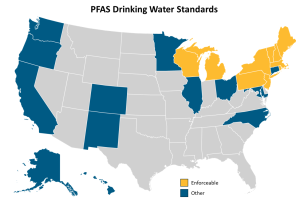New Approved PFAS Testing Methods
Posted: March 27th, 2024
Authors: Madeline S.
As a follow up to our 2024 PFAS Look Ahead, the U.S. Environmental Protection Agency (EPA) Office of Water published Methods 1633 and 1621 in January. In the past, Method 537.1 has been modified to meet analytical needs. With the publication of these testing methods, the door has been opened for additional federal regulation of Per- and polyfluoroalkyl substances (PFAS).
At present, a National Primary Drinking Water Regulation (NPDWR) has been proposed to establish MCLs for six PFAS in drinking water: perfluorooctanoic acid (PFOA), perfluorooctane sulfonic acid (PFOS), perfluorononanoic acid (PFNA), hexafluoropropylene oxide dimer acid (HFPO-DA [GenX]), perfluorohexane sulfonic acid (PFHxS), and perfluorobutane sulfonic acid (PFBS).
In the meantime, many states are taking the lead by setting their own drinking water standards and regulations. So far, ten states have enforceable standards (e.g., MCLs) for PFAS chemicals, and 13 others have adopted other standards such as guidance levels, notification levels, health advisories, or some combination of the three.
Methods for Industrial Wastewater & Stormwater
Method 1621
Worried about PFAS in your wastewater? The EPA’s Method 1621 can be a helpful first step. This method quickly and affordably screens for a broad range of organofluorine compounds at very low levels. PFAS are the most common sources of these compounds that are also found in pesticides and pharmaceuticals. While this method can’t tell you exactly which PFAS compounds or what quantities are present, it can identify samples with potentially problematic levels of organofluorines.
Think of Method 1621 as a red flag: if the screening shows high levels of organofluorines, it suggests further investigation might be needed. For a more detailed picture, specific analytical methods would be required to pinpoint the exact types and amounts of PFAS present.
In the field, 100-mL samples are collected in triplicate using high-density polyethylene or polypropylene bottles. Free-flowing wastewater is collected as grab samples or in refrigerated bottles using automated equipment. The pooled method detection limit (MDL) from the multi-laboratory validation study is 1.5 µg F–/L, and the minimum level of quantitation (ML) is 5.0 µg F–/L.
Method 1633
If results from your wastewater screening with Method 1621 indicate that you should dig deeper, the EPA’s Method 1633 has you covered: published in January 2024, this method tests for 40 PFAS analytes in eight different environmental matrices, including wastewater, surface water, groundwater, soil, biosolids, sediment, landfill leachate, and fish tissue. The method can be utilized for various applications, including for National Pollutant Discharge Elimination System (NPDES) permits.
The sampling procedure for Method 1633 differs significantly depending on the sample itself. For example, samples taken from free-flowing sources are collected as grab samples, while those from still waters must account for the enrichment of PFAS in the surface layer; leachate samples from landfills need only measure 100 mL due to the significant challenges they pose, while all other samples require 500 mL. The method detection limit (MDL) ranges from 0.32 to 9.59 ng/L for aqueous samples. Specific details can be found in the EPA Method 1633 January 2024 publication.
SW-846 Test Method 8327
The EPA’s Test Method 8327 can also be utilized to confirm the presence of PFAS in surface water, groundwater, and wastewater. This method is contained in the SW-846 Compendium, which is instrumental in compliance with Resource Conservation and Recovery Act (RCRA) regulations. It accurately measures 24 PFAS analytes, 10 of which are primarily sulfonic acids.
Methods for Drinking Water
Method 537.1
In 2009, U.S. EPA published Method 537 to evaluate for 14 different PFAS in drinking water using solid-phase extraction (SPE) followed by liquid chromatography with tandem mass spectrometry (LC/MS/MS). Updated in 2018, Method 537.1 now includes four additional PFAS for a total of 18 analytes and is approved to monitor PFAS during Unregulated Contaminant Monitoring Rule 5 (UCMR5, 2023-2025) which measures 29 PFAS plus lithium. In this method, 250-mL drinking water samples are collected and combined with Trizma, a preservation reagent that eliminates free chlorine from the sample. The lowest concentration minimum reporting level (LCMRL) of this method ranges from 0.5 to 6.3 ng/L for various PFAS.
Method 533
Also utilized to evaluate drinking water, U.S. EPA published Method 533 in 2019, in addition to Method 537.1, to evaluate PFAS. This method places an emphasis on short chain PFAS (e.g., those whose carbon chains have a length between four and 12), captures 11 of these short chain analytes as well as 14 of the 18 PFAS tested by Method 537.1, and is also approved to monitor PFAS during UCMR5. Using Methods 537.1 and 533 in tandem, drinking water can be tested for a total of 29 PFAS. Although these two EPA Methods complement each other, they also differ significantly in several ways. An example is the addition of ammonium acetate to the collected drinking water samples. The LCMRL of this method ranges from 1.4 to 16 ng/L for various PFAS.
Looking Ahead
Comprehensive PFAS Testing Solutions for Water
The U.S. EPA offers various methods for analyzing PFAS in different water types, including drinking water, groundwater, surface water, and wastewater. This aligns with their PFAS Strategic Roadmap, which includes establishing MCLs for drinking water.
Uncertain about PFAS Testing Requirements or Methods?
Selecting the Right PFAS Test Method for Your Needs
Choosing the most suitable PFAS testing method is crucial for accurate and informative results. Here are some key factors to consider:
- Sample Type: The type of sample you’re analyzing (industrial wastewater, stormwater, drinking water, etc.) greatly influences the appropriate method. This blog post focuses on industrial wastewater and stormwater sampling.
- Specific PFAS Analytes: Are you interested in a broad screening of all potential PFAS or targeting specific PFAS compounds? Different methods cater to these needs.
- Detection Limits: How low of a concentration do you need to detect? This depends on your specific concerns and regulatory requirements.
ALL4 can help you make the critical decision on which test method best fits your situation.
Finding Certified Laboratories
Once you’ve identified a suitable method based on your sample type and needs, it’s essential to find a certified laboratory for analysis. ALL4 can assist you in this process by helping you:
- Match your project requirements with laboratories that hold the necessary certifications for your chosen PFAS testing method.
- Navigate the complexities of PFAS analysis and ensure you receive accurate and reliable results.
Sample Collection
The ubiquity of PFAS provides ample opportunity for cross-contamination in the sampling environment. Here are some possible sources of interference to consider:
- Materials & Equipment: Did you know that PFAS may still be present even if not listed on a safety data sheet? HPDE, polypropylene, silicone, and acetate have been proven to be most reliable for PFAS sampling, whereas glass is known to adsorb PFAS over extended periods of contact.
- Field Clothing: Do you have any clothes that were made to resist water, dirt, or stains? If so, they probably contain PFAS and are unsuitable for the sampling environment. Your best bet is to wear 100% cotton clothing.
- Personal Care Products: Items we use daily (e.g., cosmetics, deodorant, moisturizer, etc.) and during long periods outdoors (e.g., sunscreen, bug spray) can be detrimental to the sampling environment and should only be used in the staging area.
- Food Packaging: Pre-wrapped foods and snacks should be avoided altogether in the sampling environment if at all possible but can be handled or eaten in the staging area if necessary.
ALL4 can help you reduce the likelihood of contamination in your sampling environment by developing a project-specific quality assurance project plan (QAPP) and conducting an evaluation of your material inventory to ensure that any sampling you may conduct proceeds without cross-contamination.
If you’re unsure whether your state or facility needs PFAS testing, which method is most suitable for your situation, or require guidance on sampling and analysis strategies, contact our team at ALL4. Our experts, Madeline Statkewicz (mstatkewicz@all4inc.com), Tia Sova (tsova@all4inc.com), or Kyle Costello (kcostello@all4inc.com), can assist you.


